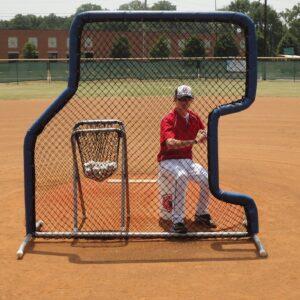Mastering the Baseball Swing: The Critical Importance of Head Position
In the intricate world of baseball hitting mechanics, one fundamental element stands above all others: keeping your head down. This seemingly simple concept serves as the cornerstone for developing a consistent, powerful swing. Whether you’re a youth player just starting out or an experienced athlete looking to refine your technique, understanding proper head position can transform your performance at the plate.
Why Your Head Position Matters
The head functions as the anchor for your entire swing. When your head maintains proper position, everything else falls into place naturally. As the saying goes among hitting coaches:
If your head position breaks down, the rest of your body follows. You have to be able to keep your head still and stay in an area to give yourself a chance to hit the baseball.
Proper head position creates a cascade of positive effects throughout your swing mechanics:
- It naturally positions your shoulders and hips correctly
- It allows you to make adjustments to different pitchers
- It provides a stable foundation to refine other swing elements
- It keeps your head behind the ball for optimal contact
When your head is out of position, it serves as a clear indicator that fundamental aspects of your swing have gone awry. This makes head position not just important in itself, but a valuable diagnostic tool for identifying broader mechanical issues.
Common Factors That Disrupt Head Position
Several tendencies cause hitters to struggle with maintaining proper head position:
- Drifting and trying to cover too much of the strike zone at once
- Leaking forward prematurely to avoid being late on pitches
- Opening up early due to anxiety about inside pitches
- Mental pressure causing overcompensation in mechanics
These issues stem from a combination of physical and psychological factors. When batters feel pressure—whether from game situations, mechanical uncertainty, or external expectations—they often abandon disciplined mechanics in favor of compensatory movements that feel more secure in the moment.
The Mental Game: Trying to Do Too Much
Baseball hitting is as much mental as physical. Various factors can influence your mindset at the plate: A positive and focused approach can enhance your performance and lead to better results. Embracing a championship mindset in mountain baseball allows players to navigate the pressures of the game while maintaining confidence and composure. By cultivating mental resilience, athletes can turn challenges into opportunities for growth and success.
- Nervousness in high-pressure situations
- Discomfort with your batting stance
- Distraction from the pitcher’s motion or crowd noise
- Excessive energy leading to mechanical overexertion
These mental pressures often manifest physically as either overloading (trying too hard) or underloading (being too passive) in your swing. Both extremes compromise head position and disrupt the swing’s natural flow.
Interestingly, during hot streaks when hitters feel “in the zone,” they typically maintain excellent head position without conscious effort. This demonstrates how proper head position correlates directly with peak performance.
The “Spot Across the Way” Drill
One effective method for developing consistent head position comes from observing MLB greats like Hall-of-Famer Jim Thome and Frank Thomas. This drill has been adopted by numerous professional hitters to maintain proper head orientation throughout their swings.
The concept is straightforward but powerful:
- Make an “X” mark on the ground past the front corner of the opposite batter’s box
- Focus your vision on this spot during your swing
- Maintain this visual focus through contact
This creates the optimal 45-degree angle between the path of the incoming pitch and the opposite batter’s box at the moment of contact.
The Headlight Drill: Perfect Your Head Position
To develop muscle memory for proper head position, try this effective training exercise:
- Attach a headlamp to your batting helmet or cap
- Set up in your batting stance in a darkened environment (ensuring no people or objects are in your swing path)
- Take several practice swings without the light, stopping at the contact position
- When you feel you’re in the correct position, turn on the headlamp
- If your head position is correct, the light beam will illuminate the target area (your “X” spot)
This visual feedback immediately shows whether your eyes, nose, and chin are properly aligned at contact. With repetition, your body develops the neuromuscular patterns needed to maintain this position consistently.
Signs You’re Keeping Your Head Down Properly
When your head position is correct, several positive outcomes typically follow:
- Increased confidence at the plate
- Feeling “locked in” during hot streaks
- Ability to track pitches more effectively
- Consistent contact with the ball’s sweet spot
- Natural rhythm and timing in your swing
These performance indicators suggest your head is serving its proper role as the stable anchor point for your entire swing mechanism.
The Correct Head Position Explained
The ideal head position at contact places your line of sight at approximately a 45-degree angle between the path of the incoming pitch and the opposite batter’s box. This orientation allows you to:
- Track the ball effectively throughout its entire flight
- Maintain a stable center of gravity
- Keep your shoulders in the proper rotational plane
- Prevent premature hip rotation
By establishing this position consistently, you create the foundation for all other aspects of a successful swing to build upon.
Putting It All Together
Mastering head position isn’t just about following a technical instruction—it’s about developing a feel for proper mechanics that becomes second nature. The best hitters don’t consciously think about keeping their heads down during games; rather, they’ve internalized this fundamental principle through disciplined practice.
By focusing on head position as a primary mechanical element, you’ll discover that many other swing flaws naturally resolve themselves. Your balance improves, your timing becomes more consistent, and your ability to adjust to different pitches increases dramatically.
Remember that baseball hitting is both an art and a science. While understanding the mechanics is crucial, developing the feel for proper execution through repetition is equally important. Commit to maintaining proper head position, and watch as your overall hitting performance transforms.





